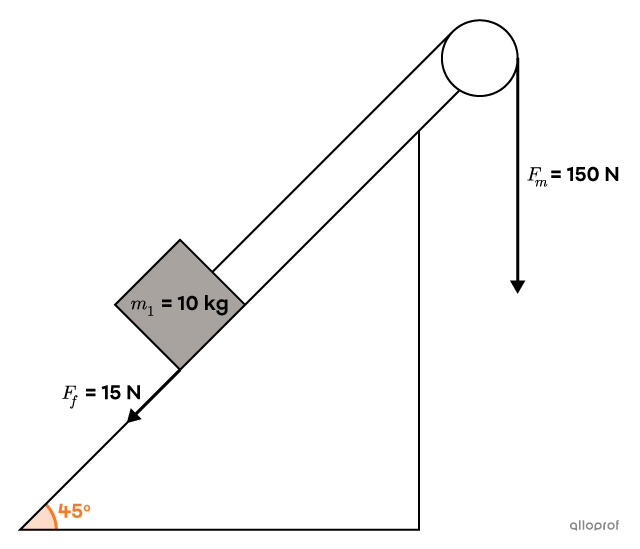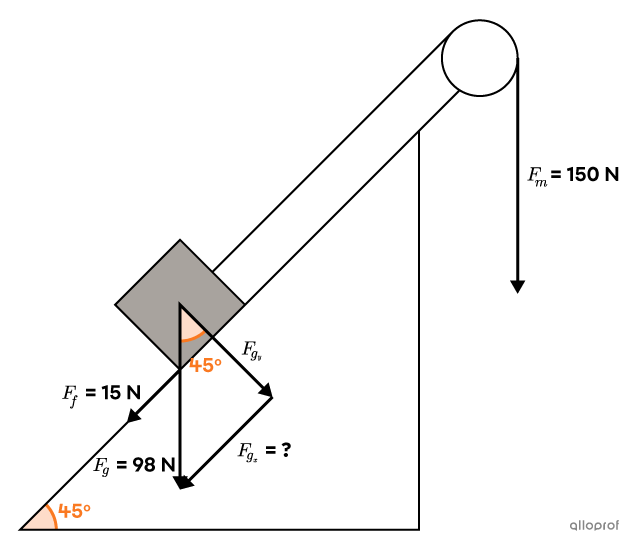Newton's second law, or fundamental principle of dynamics, states that a resultant force exerted on an object is always equal to the product of the object's mass and its acceleration. Furthermore, the acceleration produced and the resultant force have the same orientation.
Any force applied to an object causes that object to accelerate in the direction of the applied force. When several forces are applied to an object, we need to determine the resultant force, or the force that is equal to the sum of the vectors which represent all the forces acting on the object.
Newton's second law can be summed up by applying the following equation:
|\overrightarrow{F_R} = m\overrightarrow{a}|
where
|\overrightarrow{F_R}| represents the resultant force |\text {(N)}|
|m| represents the mass of the object |\text {(kg)}|
|\overrightarrow{a}| represents the object's acceleration |\text {(N/kg or m/s}^2)|
From this relationship, we can establish that acceleration is inversely proportional to mass. When two objects of different masses have same force applied to them separately, the acceleration of the lighter object will be greater.
To find the resultant force, we need to add the vectors, which means adding every force together, while taking into account the orientation of each of them.
A teenager applies a force of |50 \: \text {N}| to a |\small 10 \: \text {kg}| sled, which is opposed by a force of friction of |15 \: \text {N}.| What is the sled's acceleration?

First, it must be specified that the force of friction always opposes the movement of an object. The value of the force of friction will therefore be negative, since it is oriented in the opposite direction to the movement.
||\begin{align} F_{d} &= 50 \: \text {N} &F_{f} &= - 15 \: \text {N}\\
F_R &= \: ? \end{align}||
||\begin{align} F_{R} = F_{d} + F_{f}
\quad \Rightarrow \quad
{F}_{R} &= 50 \: \text {N} - 15 \: \text {N} \\
&= 35 \: \text {N} \end{align}||
Now it's possible to determine the acceleration of the sled.
||\begin{align} F_{R} &= 35 \: \text {N} &m &= 10 \: \text {kg}\\
a &= \: ? \end{align}||
||\begin{align} F_{R} = m \times a
\quad \Rightarrow \quad
a &= \frac {F_R}{m}\\
&= \frac {35 \: \text {N}}{10 \: \text {kg}} \\
&= 3.5 \: \text {m/s}^2 \end{align}||
The sled's acceleration is therefore |3.5\: \text {m/s}^2| to the right.
An object with a mass of |10 \ \text {kg}| is placed on a plane inclined at | 45^{\circ}.| A force of |150 \ \text {N}| is applied to make it move up the plane with a force of friction of |15 \ \text {N}.| What is the acceleration of the mass if there is no friction with respect to the the pulley?

To find the acceleration of the object, we need to add all the forces that are parallel to the plane. The force of friction |(F_f)| is given, but to find the value of the gravitational component that is parallel to the plane, we need to use the trigonometric ratios of a right triangle.
By definition, gravitational force |(F_g)| is a force of attraction (in this case, by the Earth) that is always directed downwards (towards the center of the Earth).

On an inclined plane, the angle between the vertical component of the gravitational force and the gravitational force is equal to that of the plane. We can therefore illustrate this using a right triangle where the side that is opposite the |45^{\circ}| angle represents the component of the gravitational force that is parallel to the plane.

||\begin{align} \sin \theta = \dfrac {{F_g}_x}{F_g}\ \Rightarrow \ {F_g}_x &= \sin \theta \times {F_g} \\
&= 98\ \text {N} \times \sin 45^{\circ} \\
&= 69.3\ \text {N} \end{align}||
Next, we need to determine the resultant force |(F_R)| applied to the object.

||\begin{align} F_{R} = F_{d} - {F_g}_x - F_{f}
\ \Rightarrow \
{F}_{R} &= 150 \ \text {N} - 69.3 \ \text {N} - 15 \ \text {N} \\
&= 65.7 \ \text {N} \end{align}||
Using Newton's second law, it is now possible to determine the acceleration |(a).|
||\begin{align} F_{R} = m a
\ \Rightarrow \
a &= \dfrac {F_R}{m}\\
a &= \dfrac {65{.}7 \ \text {N}}{10 \ \text {kg}} \\
a &= 6.57 \ \text {m/s}^2 \end{align}||
The acceleration is |6.57\ \text {m/s}^2| towards the top of the inclined plane.
To validate your understanding of Newton's second law in an interactive way, consult the following Crash Course:

To validate your understanding of vector decomposition in an interactive way, consult the following Crash Course:
